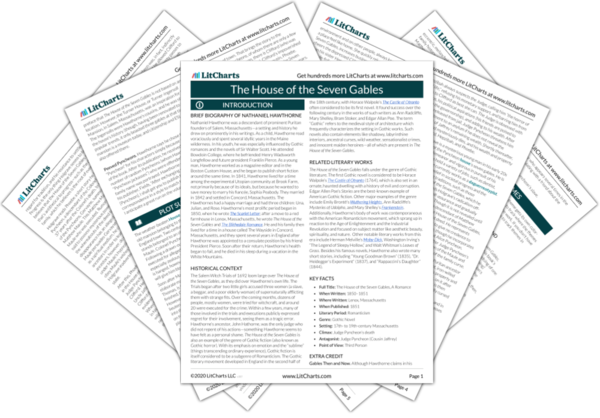Throughout the novel, portraits and daguerreotypes (a primitive form of photography) symbolize the essence of individual’s characters—especially characters, like Judge Pyncheon, whose public personas are a false front. The hardness evident in the Judge’s daguerreotype indicates that, despite his smiling exterior, he’s actually a cold-hearted person, resembling the portrait of his ancestor Colonel Pyncheon. By extension, Holgrave’s role as a daguerreotypist suggests that he sees through things to their internal reality. Additionally, Colonel Pyncheon’s portrait has been concealing the family’s long-sought land deed for 200 years—a literal example of a portrait containing the truth (in this case, the truth of the Pyncheons’ empty aspirations).
Portrait and Daguerreotype Quotes in The House of the Seven Gables
"l can assure you that this is a modern face, and one which you will very probably meet. Now, the remarkable point is, that the original wears, to the world's eye—and, for aught I know, to his most intimate friends—an exceedingly pleasant countenance, indicative of benevolence, openness of heart, sunny good humor, and other praiseworthy qualities of that cast. The sun, as you see, tells quite another story, and will not be coaxed out of it, after half a dozen patient attempts on my part. Here we have the man, sly, subtle, hard, imperious, and, withal, cold as ice. […] And yet, if you could only see the benign smile of the original! It is so much the more unfortunate, as he is a public character of some eminence, and the likeness was intended to be engraved."
Then, all at once, it struck Phoebe that this very Judge Pyncheon was the original of the miniature which the daguerreotypist had shown her in the garden, and that the hard, stern, relentless look now on his face was the same that the sun had so inflexibly persisted in bringing out. Was it, therefore, no momentary mood, but, however skillfully concealed, the settled temper of his life? And not merely so, but was it hereditary in him, and transmitted down, as a precious heirloom, from that bearded ancestor […] as by a kind of prophecy? […] It implied that the weaknesses and defects […] and the moral diseases which lead to crime are handed down from one generation to another, by a far surer process of transmission than human law has been able to establish[.]
[B]esides these cold, formal, and empty words of the chisel that inscribes, the voice that speaks, and the pen that writes, for the public eye […] there were traditions about the ancestor, and private diurnal gossip about the Judge, remarkably accordant in their testimony. It is often instructive to take the woman's, the private and domestic, view of a public man; nor can anything be more curious than the vast discrepancy between portraits intended for engraving and the pencil sketches that pass from hand to hand behind the original's back.
[Holgrave] could talk sagely about the world's old age, but never actually believed what he said; he was a young man still, and therefore looked upon the world—that gray-bearded and wrinkled profligate, decrepit without being venerable—as a tender stripling, capable of being improved into all that it ought to be, but scarcely yet had shown the remotest promise of becoming. […] It seemed to Holgrave—as doubtless it has seemed to the hopeful of every century since the epoch of Adam's grandchildren—that in this age, more than ever before, the moss-grown and rotten Past is to be torn down, and lifeless institutions to be thrust out of the way, and their dead corpses buried, and everything to begin anew.
[The legend] here gives an account of some very strange behavior on the part of Colonel Pyncheon's portrait. This picture, it must be understood, was supposed to be so intimately connected with the fate of the house, and so magically built into its walls, that, if once it should be removed, that very instant the whole edifice would come thundering down in a heap of dusty ruin. All through the foregoing conversation between Mr. Pyncheon and the carpenter, the portrait had been frowning, clenching its fist, and giving many such proofs of excessive discomposure, but without attracting the notice of either of the two colloquists. And finally, at Matthew Maule's audacious suggestion of a transfer of the seven-gabled structure, the ghostly portrait is averred to have lost all patience, and to have shown itself on the point of descending bodily from its frame. But such incredible incidents are merely to be mentioned aside.
“My dearest Phoebe,” said Holgrave, "how will it please you to assume the name of Maule? As for the secret, it is the only inheritance that has come down to me from my ancestors. You should have known sooner (only that I was afraid of frightening you away) that, in this long drama of wrong and retribution, I represent the old wizard, and am probably as much a wizard as ever he was. The son of the executed Matthew Maule, while building this house, took the opportunity to construct that recess, and hide away the Indian deed, on which depended the immense land claim of the Pyncheons. Thus they bartered their Eastern territory for Maule's garden ground.












